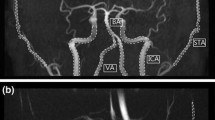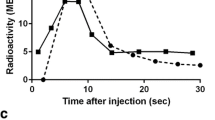Abstract
Hyperthermia can be the result of many causes such as environmental conditions, brain tumors and infectious diseases. Since hyperthermia is very common, its role in causing stroke through a decrease in cerebral blood flow needed further emphasis. The aim of this study was to record cerebral blood flow in vitro by using isolated rabbit carotid artery strips and in-vivo using radioactive isotope scanning during temperature elevation. The recording of isometric tension in rabbit carotid artery strips in organ baths, and the scintigraphic cerebral imaging of technetium-99m-hexamethyl-propyleneamineoxime (99mTc-HMPAO) using Gamma camera, were acquired at control and higher body temperature by 4°C. Blood pressure was measured through femoral artery and cerebral blood flow was measured through carotid artery. Elevating temperature by 4°C induced reproducible contraction. During hyperthermia, the carotid artery contraction leads to a decrease in cerebral blood flow although the blood pressure did not decrease. The uptake of 99mTc-HMPAO in the brain was significantly reduced. This decrease in cerebral perfusion is regionally dependent, which is more in the frontal area, the cerebral hemispheres than the cerebellum. The decrease was 36 ± 3, 37 ± 2, 22 ± 2%, respectively. Hyperthermia causes carotid artery contraction leading to decrease in cerebral blood flow, which was confirmed by 99mTc-HMPAO images. The decrease is regionally dependent. Since the blood pressure did not decrease by heating, the reduction in cerebral perfusion is mainly due to carotid contraction. The applied neck cooling may be considered as a promising therapeutic strategy for the hyperthermic patient to avoid brain damage. This can be achieved by external application of an ice-water-perfused neck collar.




Similar content being viewed by others
References
Bouchama A, Knochel JP (2002) Heat stroke. N Engl J Med 346:1978–1988
Brozmanova A, Zila I, Javorka K, Porubcan J, Kapsova J (2004) Effects of acute normovolemic haemodilution on cardiorespiratory changes in hyperthermia and its physical treatment. Int J Hyperthermia 20(8):851–864
Desrulle AV, Candas V (2000) Thermoregulatory effects of three different types of head cooling in humans during a mild hyperthermia. Eur J Appl Physiol 81(1–2):33–39
Ell PJ, Hocknell JML, Jarritt PH et al (1985) A Tc-99m labeled radiotracer for the investigation of cerebral vascular disease. Nucl Med Comm 6:437–441
Green H, Gilbert J, James R, Byard RW (2001) An analysis of factors contributing to a series of deaths caused by exposure to high environmental temperatures. Am J Forensic Med Pathol 22:196–199
Hamel E, Edvinsson L, MacKenzie ET (1988) Heterogenous vasomotor responses of anatomically distinct feline cerebral arteries. Br J Pharmacol 94(2):423–436
Marder J, Eylath U, Moskovitz E, Sharir R (1990) The effect of heat exposure on blood chemistry of the hyperthermic rabbit. Comp Biochem Physiol A 97(2):245–247
Mustafa SM, Thulesius O (2001) Cooling is a potent vasodilator of deep vessels in the rat. Can Physiol Pharmacol 79:899–904
Mustafa S, Thulesius O (2002) Cooling induced carotid artery dilatation, an experimental study in isolated vessels. Stroke 33:256–260
Mustafa S, Thulesius O, Ismael HN (2004) Hyperthermia-induced vasoconstriction of the carotid artery, a possible causative factor of heatstroke. J Appl Physiol 96:1875–1878
Nakamura K, Tukatani Y, Kubo A et al (1989) The behavior of 99m-Tc HMPAO in blood and brain. Eur J Nucl Med 15:100–107
Nolte J (1999) Human brain. An introduction to its functional anatomy, 4th edn. Mosby, St Louis
Sprung CL, Portocarrero CJ, Fernaine AV, Weinberg PF (1980) The metabolic and respiratory alterations of heat stroke. Arch Intern Med 140(5):665–669
Suzuki Y, Satoh S, Oyama H, Takayasu M, Sibuya M (1993) Regional differences in vasodilator response to vasopressin in canine cerebral arteries in vivo. Stroke 24(7):1049–1053
Xi L, Takin D, Bhargava P, Kukreja A (2001) Whole body hyperthermia and preconditioning of the heart: basic concepts, complexity, and potential mechanisms. Int J Hyperthermia 17:439–455
Acknowledgment
We acknowledge Mrs. Sati Gopinath and Mrs. Merci Mathew, Nuclear Medicine Department, Faculty of Medicine, Kuwait University for their valuable technical support.
Author information
Authors and Affiliations
Corresponding author
Rights and permissions
About this article
Cite this article
Mustafa, S., Elgazzar, A.H. & Ismael, H.N. Influence of hyperthermia on carotid blood flow using 99mTc-HMPAO. Eur J Appl Physiol 101, 257–262 (2007). https://doi.org/10.1007/s00421-007-0493-9
Accepted:
Published:
Issue Date:
DOI: https://doi.org/10.1007/s00421-007-0493-9




